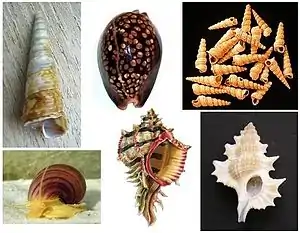Apogastropoda
Die Apogastropoda (altgr. ἀπό=aus,davon; altgr. γαστήρ=Bauch,Magen; gr.πόδι=Bein,Fuß) bilden ein Taxon in der Systematik der Biologie (Weichtiere, Schnecken). Es vereint die phylogenetischen Schwesterngruppen der Caenogastropoda und Heterobranchia.
| Apogastropoda | ||||||||||
|---|---|---|---|---|---|---|---|---|---|---|

Beispiele von Apogastropoda | ||||||||||
| Systematik | ||||||||||
| ||||||||||
| Wissenschaftlicher Name | ||||||||||
| Apogastropoda | ||||||||||
| Salvini-Plawen & Haszprunar, 1987[1] |
Das Taxon wurde 1987 bekannt gemacht.[1] In der Systematik von Ponder & Lindberg (1997)[2] ist es als Teilklasse der Unterklasse der Orthogastropoda vertreten. In der Systematik von Bouchet & Rocroi (2005)[3][4][5] entfällt das Taxon wieder.
Beschreibung
Die zu diesem Taxon gehörenden Gastropoda haben verzweigte tentakelartige Nerven und zwei Verbindungsstränge.[6]
Systematik
Gemäß Ponder & Lindberg (1997) bilden die Caenogastropoda und Heterobranchia im phylogenetischen System Schwesterngruppen und wurden zum Monophylum Apogastropoda[7][8] vereinigt.
Die Apogastropoda ordnen sich in der Taxonomie von Ponder & Lindberg (1997) wie folgt ein:
- Unterklasse Orthogastropoda (Echte Schnecken), W.F. Ponder & D.R. Lindberg, 1996
- Teilklasse Apogastropoda, L. Salvini-Plawen & G. Haszprunar, 1987
- Überordnung Caenogastropoda, Cox, 1960
- Ordnung Architaenioglossa, Haller, 1890
- Ordnung Sorbeoconcha, W.F. Ponder & D.R. Lindberg, 1997
- Überordnung Heterobranchia (Verschieden-Kiemer), J.E. Gray, 1840
- Ordnung Heterostropha (Verschieden-Dreher), P.H. Fischer, 1885
- Ordnung Opisthobranchia (Hinterkiemerschnecken), A. Milne-Edwards, 1848
- Ordnung Pulmonata (Lungenschnecken), G. Cuvier in H.M.D. de Blainville, 1814
- Überordnung Caenogastropoda, Cox, 1960
- Teilklasse Apogastropoda, L. Salvini-Plawen & G. Haszprunar, 1987
In der neueren Taxonomie von Bouchet & Rocroi (2005) wird das Taxon der Apogastropoda jedoch nicht mehr genutzt. Es gilt aufgrund molekularbiologischer Gründe[9] als überholt.
Einzelnachweise
- Salvini-Plawen, L. von & Haszprunar, G.: 1987; The Vetigastropoda and the systematics of streptonerous Gastropoda (Mollusca); Journal of Zoology, London, 211(4):762.
- Ponder, W.F. und Lindberg, D.R.: Towards a phylogeny of gastropod molluscs: an analysis using morphological characters; In: Zoological Journal of the Linnean Society; Band 119, Nr. 2, 1997, S. 83–265; doi:10.1111/j.1096-3642.1997.tb00137.x
- Bouchet, P. & Rocroi, J.-P.: Part 2; Working classification of the Gastropoda; In: Malacologia Band 47, S. 239–283, Ann Arbor 2005; ISSN 0076-2997
- Bouchet, P. und Rocroi, J.-P. (Hrsg.): J. Frýda, B. Hausdorf, W. F. Ponder, Á. Valdés und A. Warén: Classification and nomenclator of gastropod families; In: Malacologia: International Journal of Malacology Band 47, Nr. 1–2; ConchBooks, Hackenheim 2005; ISBN 3-925919-72-4, ISSN 0076-2997, http://www.vliz.be/Vmdcdata/imis2/ref.php?refid=78278
- Poppe, G.T. und Tagaro, S.P.: The New Classification of Gastropods according to Bouchet & Rocroi, 2005 (Memento vom 27. September 2007 im Internet Archive; PDF)
- http://Britannica.com - Online-Service des Lexikons Britannica
- Haszprunar G.: On the origin and evolution of major gastropods group, with special reference to the Streptoneura.. In: Journal of Molluscan Studies. 54, 1988, S. 367–441. doi:10.1093/mollus/54.4.367.
- Salvini-Plawen, L., Steiner, G.: Synapomorphies and plesiomorphies in higher classification of Mollusca. In Origin and evolutionary radiation of the Mollusca. In: JThe Malacological Society of London. 1996, S. 29–51.
- Cristina Grande, José Templado and Rafael Zardoya: Evolution of gastropod mitochondrial genome arrangements. In: BMC Evolutionary Biology. 8, Nr. 61, 2008, S. 61. doi:10.1186/1471-2148-8-61.